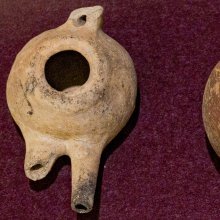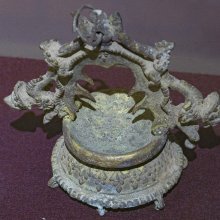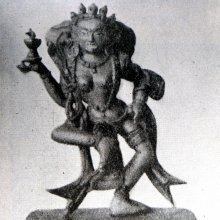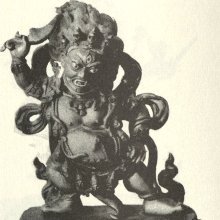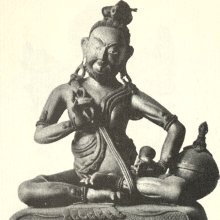Dipa, Dīpa: 32 definitions
Introduction:
Dipa means something in Buddhism, Pali, Hinduism, Sanskrit, Jainism, Prakrit, Marathi, Hindi. If you want to know the exact meaning, history, etymology or English translation of this term then check out the descriptions on this page. Add your comment or reference to a book if you want to contribute to this summary article.
Images (photo gallery)
(+12 more images available)
In Hinduism
Shaktism (Shakta philosophy)
Source: Wisdom Library: ŚāktismDīpa (दीप, “light”):—One of the five preliminary oblations (upacāra) to be offered during the worship of Gaṇeśa, Durgā, Śiva and Viṣṇu, according to the Durgāpūjātattva.
Source: Google Books: ManthanabhairavatantramDīpa (दीप) is the name of the Cremation Ground (śmaśāna) associated with Pūrṇagiri, one of the sacred seats (pīṭha), according to the Ṣaṭsāhasrasaṃhitā, an expansion of the Kubjikāmatatantra: the earliest popular and most authoritative Tantra of the Kubjikā cult.—On the basis of hardly more than a hint in the Ṣaṭsāhasrasaṃhitā, it outlines a scheme of sixteen parts for each seat, conscious, no doubt, that this is an ideal number. The commentary normally limits itself to do no more than explain what is presented in the text. This is one of the few instances it adds substantially to its contents [i.e., the Cremation Grounds—Dīpa]. Presumably this is because when it was written the presentation of the features of the seats on this model was the accepted norm.

Shakta (शाक्त, śākta) or Shaktism (śāktism) represents a tradition of Hinduism where the Goddess (Devi) is revered and worshipped. Shakta literature includes a range of scriptures, including various Agamas and Tantras, although its roots may be traced back to the Vedas.
Purana and Itihasa (epic history)
Source: archive.org: Shiva Purana - English Translation1) Dīpa (दीप, “lamps”) refers to “offering of lamps” and represents one of the sixteen upacāra, or “sixteen types of homage and services”, as described while explaining the mode of worshipping the phallic form (liṅga) of Śiva in the Śivapurāṇa 1.11. Accordingly, “[...] the devotee shall worship the mobile emblem with the sixteen types of homage and services (upacāra) as prescribed. It accords the region of Śiva gradually. The sixteen types of service are [for example, offering of lamps (dīpa)] [...] Or he shall perform all the sixteen rites in the phallic emblem of human, saintly or godly origin, or in one naturally risen up (svayambhū) or in one of very extraordinary nature installed duly”.
Dīpa or Dīpasamarpaṇa (offering of the lamp) is also mentioned in the Śivapurāṇa 1.20, while explaining the mode of worshipping an earthen phallic image (pārthiva-liṅga) according to the Vedic rites:—“[...] the incense shall be offered with the mantra ‘Namaḥ Kapardine ca’ etc. in accordance with the rules. The lamp (dīpa) shall be offered in the prescribed manner with the mantra ‘Namaḥ Āśave’ etc.”.
2) Dīpa (दीप, “lamps”) refers to a “lamp”, to be used in the worship of Śiva, according to the Śivapurāṇa 2.1.13:—“[...] the lamp (dīpa) shall be shown then. Homage shall be paid to the preceptor (Guru). He shall then seat (āsana) himself in the yogic poses of Padma, Bhadra, Uttāna or Paryaṅka whichever is convenient and perform the rites once again. After the worship he shall float it along with the cake (vaṭaka). If the worship is performed in the house these rules are not binding”.
Source: Shodhganga: The saurapurana - a critical studyDīpa (दीप) refers to one of the various kinds of articles used for donation, according to the 10th century Saurapurāṇa: one of the various Upapurāṇas depicting Śaivism.—Accordingly, the tenth chapter contains the praise and classification of donations. It narrates the characteristics of proper recipients and the results of giving different kinds of articles like Bhūmi, Vidyā, Anna, Jala, Tila, Vāsa, Dīpa, Yāna, Śayyā, Dhānya, Aśva, Śāka, Indhana, Chatra, Auṣadha, Go, etc.

The Purana (पुराण, purāṇas) refers to Sanskrit literature preserving ancient India’s vast cultural history, including historical legends, religious ceremonies, various arts and sciences. The eighteen mahapuranas total over 400,000 shlokas (metrical couplets) and date to at least several centuries BCE.
Shaivism (Shaiva philosophy)
Source: Shodhganga: Temple management in the ĀgamasDīpa (दीप) refers to a “lamp, waved in ritual action” and represents one of the various upacāras (offerings), in pūjā (ritual worship), as defined in the Śaivāgamas.—Pūjā consists of offering hospitality, in the form of water to wash the feet, to drink, water for ablutions, offering a bath, new clothes, fragrant unguents, fragrant flowers and ornaments, food and so on. Each step in the pūjā process is called “saṃskāra” and each offering is called “upacāra” [viz., Dīpa].
Dīpa refers to one of the eight aṣṭamaṅgala and represents a type of “temple implement (instrument)” as described in the Karaṇalakṣaṇavidhi-paṭala section of the Uttara-Kāmikāgama.—The instruments should be according to the particular śāstra followed at the temple. Some of the instruments mentioned are Śaiva aṣṭamaṅgala including [viz., dīpa].

Shaiva (शैव, śaiva) or Shaivism (śaivism) represents a tradition of Hinduism worshiping Shiva as the supreme being. Closely related to Shaktism, Shaiva literature includes a range of scriptures, including Tantras, while the root of this tradition may be traced back to the ancient Vedas.
Ayurveda (science of life)
Dietetics and Culinary Art (such as household cooking)
Source: Shodhganga: Dietetics and culinary art in ancient and medieval IndiaDīpa (दीप) refers to “lamps”, which is a topic dealt with in the dīpa-vidhi section of the Bhojanakutūhala (vibhāvarīvilāsa), and is commonly found in literature dealing with the topics of dietetics and culinary art, also known as Pākaśāstra or Pākakalā.—The vibhāvarīvilāsa which deals with the activities during night (after dinner). This section includes [viz., dīpa-vidhi (rules on lighting the lamp)].

Āyurveda (आयुर्वेद, ayurveda) is a branch of Indian science dealing with medicine, herbalism, taxology, anatomy, surgery, alchemy and related topics. Traditional practice of Āyurveda in ancient India dates back to at least the first millenium BC. Literature is commonly written in Sanskrit using various poetic metres.
Vaishnavism (Vaishava dharma)
Source: Pure Bhakti: Arcana-dipika - 3rd EditionDīpa (दीप) refers to a “ghee lamp” and represents one of the articles offered during Maṅgalārati, according to the Arcana-dīpikā (manual on deity worship).—Before each article is offered, purify the right hand [with a drop of water from the pañca-pātra], and then purify the article [viz., dīpa]. Chant the mūla-mantra for the deity and then offer the article.

Vaishnava (वैष्णव, vaiṣṇava) or vaishnavism (vaiṣṇavism) represents a tradition of Hinduism worshipping Vishnu as the supreme Lord. Similar to the Shaktism and Shaivism traditions, Vaishnavism also developed as an individual movement, famous for its exposition of the dashavatara (‘ten avatars of Vishnu’).
Jyotisha (astronomy and astrology)
Source: Wisdom Library: Brihat Samhita by VarahamihiraDīpa (दीप) refers to a “lamplight”, according to the Bṛhatsaṃhitā (chapter 2), an encyclopedic Sanskrit work written by Varāhamihira mainly focusing on the science of ancient Indian astronomy astronomy (Jyotiṣa).—Accordingly, “A true Astrologer is also one who has thoroughly mastered the Science of Saṃhitā. [...] It also treats of the prediction of events from the flight of the kañjana and from the appearance of various abnormal phenomena, of expiatory ceremonies; of miscellaneous planetary phenomena; of ghṛta-kambala; of the royal sword; of paṭa; of the features of a house cock, a cow, a sheep, a horse, an elephant, a man and a woman. It also treats of the treatment of women; of moles in the body; of injuries to shoes and clothes; of hairy fans; of walking sticks: of beds and seats; of lamplight [i.e., dīpa-lakṣaṇa]; of tooth brush and the like”.

Jyotisha (ज्योतिष, jyotiṣa or jyotish) refers to ‘astronomy’ or “Vedic astrology” and represents the fifth of the six Vedangas (additional sciences to be studied along with the Vedas). Jyotisha concerns itself with the study and prediction of the movements of celestial bodies, in order to calculate the auspicious time for rituals and ceremonies.
Yoga (school of philosophy)
Source: ORA: Amanaska (king of all yogas): A Critical Edition and Annotated Translation by Jason BirchDīpa (दीप) refers to a “lamp”, according to the Yogatārāvalī: a short Yoga text of twenty-nine verses presenting Haṭhayoga as the means to Rājayoga (i.e., Samādhi).—Accordingly, while describing the no-mind state: “When the movement of the breath is quashed through the prolonged restraint of the mind and senses, the bodies of the best Yogins become still like a lamp (nivāta-dīpa) in a windless place and their minds are immersed in the no-mind [state]”.

Yoga is originally considered a branch of Hindu philosophy (astika), but both ancient and modern Yoga combine the physical, mental and spiritual. Yoga teaches various physical techniques also known as āsanas (postures), used for various purposes (eg., meditation, contemplation, relaxation).
Ganapatya (worship of Ganesha)
Source: archive.org: Shiva Purana - (Ganesha)Dīpa (दीप) refers to “lamps” (used in the worship of Gaṇeśa), according to the Śivapurāṇa 2.4.18 (“Gaṇeśa crowned as the chief of Gaṇas”).—Accordingly, as Śiva said to Gaṇeśa: “[...] Gaṇeśa shall be adored with incense, lamps (dīpa) and different kinds of food-offerings. After worshipping you with various articles of worship like betel etc. and eulogising you with hymns, the devotee shall worship the crescent moon. Afterwards, he shall feed the brahmins joyously with sweets with due honour. He himself shall take sweets and avoid salt. [...]”.
Ganapatya (गाणपत्य, gāṇapatya) represents a tradition of Hinduism where Ganesha is revered and worshipped as the prime deity (ishta-devata). Being a minor though influential movement, Ganapatya evovled, llike Shaktism and Shaivism, as a separate movement leaving behind a large body of literature.
General definition (in Hinduism)
Source: ACHC: Smarta PujaDīpa (दीप) refers to the “offering of a lamp”, representing one of the various services (upacāra) of a pūjā (ritualistic worship of a deity) which aim at the purification of the devotee.—A small lamp (dīpa) fed with ghee (Mar. nirañjan) is offered to the icon. According to an old custom a lamp is put near the guest before a meal (cf. naivedya) is served to him. In current practice this lamp is first waved clockwise in front of the icon several times, accompanied by the ringing of the bell. The ghee lamp is then placed at the right side of the icon. This act of worship is to be distinguished from the service [mahānīrājana-dīpa], where one waves burning camphor and a lamp in front of the icon accompanied by the singing of metrical compositions.
In Buddhism
Theravada (major branch of Buddhism)
Source: Pali Kanon: Pali Proper NamesA monk, probably of Ceylon, author of the Parivarapatha (Vin.v.226).
Theravāda is a major branch of Buddhism having the the Pali canon (tipitaka) as their canonical literature, which includes the vinaya-pitaka (monastic rules), the sutta-pitaka (Buddhist sermons) and the abhidhamma-pitaka (philosophy and psychology).
Mahayana (major branch of Buddhism)
Source: Wisdom Library: Maha Prajnaparamita Sastra1) Dīpa (दीप) refers to “lamps” and is mentioned among the “material benefits” granted by the Bodhisattva, according to the Mahāprajñāpāramitāśāstra chapter XLVI.—Accordingly, “lamps (dīpa), such as tallow candles, oil lamps, wax candles, luminous pearls, etc.”.
2) Dīpa (दीप) refers to a “lamp” and represents one of the various types of upamāna (comparisons). Cf. Nirmāṇa, and the Mahāprajñāpāramitāśāstra (chapter XI).—Accordingly to the Vajracchedikā, p. 46, “The conditioned should be thought to be like a star in space, shadows, a lamp [i.e., dīpa], hoarfrost, a water bubble, a dream, a flash of lightning a cloud” (Cf. the Khotanese commentary in Hoernle, Remains, p. 287.)
Source: De Gruyter: A Buddhist Ritual Manual on AgricultureDīpa (दीप) refers to “lamps” (suitable for an offering ceremony), according to the Vajratuṇḍasamayakalparāja, an ancient Buddhist ritual manual on agriculture from the 5th-century (or earlier), containing various instructions for the Sangha to provide agriculture-related services to laypeople including rain-making, weather control and crop protection.—Accordingly [as the Bhagavān taught the detailed offering-manual], “[...] Four Nāga kings should be prepared in the middle of the ditch. [...] Various offerings should be arranged. Fruits should be scattered. Four filled jars should be placed. Four pots filled with offerings should be placed. Four ladles with frankincense and bdellium incense should be burnt. Eight lamps (aṣṭa-dīpa—aṣṭau dīpā) should be lit. [...]”.

Mahayana (महायान, mahāyāna) is a major branch of Buddhism focusing on the path of a Bodhisattva (spiritual aspirants/ enlightened beings). Extant literature is vast and primarely composed in the Sanskrit language. There are many sūtras of which some of the earliest are the various Prajñāpāramitā sūtras.
Tibetan Buddhism (Vajrayana or tantric Buddhism)
Source: archive.org: The Indian Buddhist IconographyDīpā (दीपा) refers to one of the four “Light Goddesses”, as commonly depicted in Buddhist Iconography, and mentioned in the 11th-century Niṣpannayogāvalī of Mahāpaṇḍita Abhayākara.—Her Colour is blue; her Symbol is a light stick; she has two arms.—The second Light deity is called Dīpā. [...] A statuette of this goddess occurs in the Chinese collection.
Dīpā is described in the Niṣpannayogāvalī (pañcaḍāka-maṇḍala ) as follows:—
“Dīpā is blue in colour and holds in her hands the light stick”.
[Collectively, they are conceived as nude, and as violent in appearance with garland of skulls and severed heads. They dance on a corpse in the pratyālīḍha attitude and hold their special marks of recognition in their hands.]

Tibetan Buddhism includes schools such as Nyingma, Kadampa, Kagyu and Gelug. Their primary canon of literature is divided in two broad categories: The Kangyur, which consists of Buddha’s words, and the Tengyur, which includes commentaries from various sources. Esotericism and tantra techniques (vajrayāna) are collected indepently.
In Jainism
General definition (in Jainism)
Source: The University of Sydney: A study of the Twelve ReflectionsDīpa (दीप) refers to the “light (of knowledge)”, according to the 11th century Jñānārṇava, a treatise on Jain Yoga in roughly 2200 Sanskrit verses composed by Śubhacandra.—Accordingly, “The fire of passion becomes extinguished, desire flows away, darkness disappears [and] the light of knowledge (bodha-dīpa) shines forth in the heart for men from the repetition of the reflections”.

Jainism is an Indian religion of Dharma whose doctrine revolves around harmlessness (ahimsa) towards every living being. The two major branches (Digambara and Svetambara) of Jainism stimulate self-control (or, shramana, ‘self-reliance’) and spiritual development through a path of peace for the soul to progess to the ultimate goal.
Languages of India and abroad
Pali-English dictionary
Source: BuddhaSasana: Concise Pali-English Dictionarydīpa : (m.) 1. a lamp; 2. an island; 3. help; support.
Source: Sutta: The Pali Text Society's Pali-English Dictionary1) Dīpa, 3 (cp. Sk. dvīpa tiger’s skin) a car covered with a panther’s skin J.I, 259; V, 259=VI, 48. (Page 324)
2) Dīpa, 2 (m. & nt.) (Ved. dvīpa=dvi+ap (*sp.) of āpa water, lit. “double-watered, ” between (two) waters) an island, continent (mahā°, always as 4); terra firma, solid foundation, resting-place, shelter, refuge (in this sense frequent combined w. tāṇa lena & saraṇa & expl. in Com. by patiṭṭhā) — (a) lit. island: S.V, 219; J.III, 187; VvA.19; Mhvs VII.7, 41.—continent: cattāro mahādīpā S.V, 343; Vv 2010 (=VvA.104); VvA.19; PvA.74 etc. Opp. the 2000 paritta-dīpā the smaller islands KhA 133.—(b) fig. shelter, salvation etc. (see also tāṇa): S.III, 42 (atta°+attasaraṇa etc., not with S Index to dīpa1); V, 154, 162 (id.) IV.315 (maṃ°, not to dīpa1), 372; A.I, 55 sq. (+tāṇa etc.); Sn.501 (atta° selfreliant, self-supported, not with Fausböll to dīpa1), 1092, 1094, 1145 (=Satthā); Nd2 303; Dh.236 (°ṃ karohi=patiṭṭhā PvA.87); Pv III, 19 (id. PvA.174); J.V, 501=VI, 375 (dīpañ ca parāyaṇaṃ); Miln.84, 257 (dhamma-dīpa, Arahantship).
3) Dīpa, 1 (Ved. dīpa to Ved. dī, dīpyate; Idg. *deịā to shine (see dibba, deva); cp. Gr. di/alos, dh_los; see also jotati) a lamp J.II, 104 (°ṃ jāleti to light a l.); DhA.II, 49 (id.), 94 (id.)

Pali is the language of the Tipiṭaka, which is the sacred canon of Theravāda Buddhism and contains much of the Buddha’s speech. Closeley related to Sanskrit, both languages are used interchangeably between religions.
Marathi-English dictionary
Source: DDSA: The Molesworth Marathi and English Dictionarydīpa (दीप).—m (S) A lamp. 2 A lampstand. 3 fig. A lamp or light; of which five sorts are treated in five sections of the pañcadaśīgrantha, named dhyānadīpa, citradīpa, nāṭakadīpa, tṛptidīpa, kūṭasthadīpa.
Source: DDSA: The Aryabhusan school dictionary, Marathi-Englishdīpa (दीप).—m A lamp; a lamp-stand; fig a light.
Marathi is an Indo-European language having over 70 million native speakers people in (predominantly) Maharashtra India. Marathi, like many other Indo-Aryan languages, evolved from early forms of Prakrit, which itself is a subset of Sanskrit, one of the most ancient languages of the world.
Sanskrit dictionary
Source: DDSA: The practical Sanskrit-English dictionaryDīpa (दीप).—[dīp-ṇic ac]
1) A lamp, light; नृपदीपो धनस्नेहं प्रजाभ्यः संहरन्नपि । अन्तरस्थैर्गुणैः शुभ्रैर्लक्ष्यते नैव केनचित् (nṛpadīpo dhanasnehaṃ prajābhyaḥ saṃharannapi | antarasthairguṇaiḥ śubhrairlakṣyate naiva kenacit) || Pañcatantra (Bombay) 1. 221. न हि दीपौ परस्परस्योपकुरुतः (na hi dīpau parasparasyopakurutaḥ) Ś. B.; so ज्ञानदीपः (jñānadīpaḥ) &c.
Derivable forms: dīpaḥ (दीपः).
Source: Cologne Digital Sanskrit Dictionaries: Edgerton Buddhist Hybrid Sanskrit DictionaryDīpa (दीप).—(1) name of the king of Dīpāvatī: Divyāvadāna 246.9 ff.; (2) name of a serpent king: (Ārya-)Mañjuśrīmūlakalpa 18.24; (3) m.c. for Dīpaṃ- kara: buddha Dīpa-nāmā Lalitavistara 393.12 (verse).
--- OR ---
Dīpā (दीपा).—name of a goddess or yoginī: Sādhanamālā 157.12 etc.; 324.6.
Source: Cologne Digital Sanskrit Dictionaries: Shabda-Sagara Sanskrit-English DictionaryDīpa (दीप).—m.
(-paḥ) A lamp. E. dīp to shine, affix, ka, ac or ghañ .
Source: Cologne Digital Sanskrit Dictionaries: Benfey Sanskrit-English DictionaryDīpa (दीप).—[dīp + a], m. A lamp, Bhāg. 6, 19.
Source: Cologne Digital Sanskrit Dictionaries: Cappeller Sanskrit-English DictionaryDīpa (दीप).—[masculine] light, lamp.
Source: Cologne Digital Sanskrit Dictionaries: Monier-Williams Sanskrit-English DictionaryDīpa (दीप):—[from dīp] m. a light, lamp, lantern, [Āśvalāyana-gṛhya-sūtra; Manu-smṛti; Mahābhārata etc.]
Source: Cologne Digital Sanskrit Dictionaries: Yates Sanskrit-English Dictionary1) Dīpa (दीप):—(paḥ) 1. m. A lamp.
2) Dīpā (दीपा):—nvitā (tā) 1. f. An illumination.
Source: DDSA: Paia-sadda-mahannavo; a comprehensive Prakrit Hindi dictionary (S)Dīpa (दीप) in the Sanskrit language is related to the Prakrit word: Dīva.
[Sanskrit to German]
Sanskrit, also spelled संस्कृतम् (saṃskṛtam), is an ancient language of India commonly seen as the grandmother of the Indo-European language family (even English!). Closely allied with Prakrit and Pali, Sanskrit is more exhaustive in both grammar and terms and has the most extensive collection of literature in the world, greatly surpassing its sister-languages Greek and Latin.
Hindi dictionary
Source: DDSA: A practical Hindi-English dictionaryDīpa (दीप) [Also spelled dip]:—(nm) an earthen lamp; the most eminent person of a family or clan; ~[gṛha] a light-house; ~[dāna] offering of a lamp to a deity for adoration; ~[mālā/mālikā] a row of lamps; the [divālī] festival; ~[varti/vartikā] the wick of a lamp; ~[śikhā] the flame of a lamp; ~[staṃbha] a lamp-post; —[se dīpa jale] one lamp kindles another.
...
Kannada-English dictionary
Source: Alar: Kannada-English corpusDīpa (ದೀಪ):—[noun] a tract of land completely surrounded by water, and not large enough to be called a continent; an island.
--- OR ---
Dīpa (ದೀಪ):—
1) [noun] a device furnishing artificial light; a source of light; a lamp.
2) [noun] the light.
3) [noun] ದೀಪ ಆರಿಸು [dipa arisu] dīpaārisu to put off a lamp; 2. (fig.) to cause to die; ದೀಪ ಕಂತಿಸು [dipa kamtisu] dīpa kantisu = ದೀಪ ಆರಿಸು [dipa arisu]; ದೀಪ ಕಚ್ಚಿಸು [dipa kaccisu] dīpa kaccisu = ದೀಪ ಆರಿಸು - [dipa arisu -] 1; ದೀಪ ಕಳೆ [dipa kale] dīpa kaḷe = ದೀಪ ಆರಿಸು - [dipa arisu -] 1; ದೀಪ ತುಂಬು [dipa tumbu] dīpa tumbu = ದೀಪ ಆರಿಸು - [dipa arisu -] 1; ದೀಪ ತೆಗೆ [dipa tege] dīpa tege = ದೀಪ ಆರಿಸು - [dipa arisu -] 1; ದೀಪದ ಎಣ್ಣೆ [dipada enne] dīpada eṇṇe any oil, esp. kerosene, used as a fuel in a lamp; ದೀಪದ ಕಂಬ [dipada kamba] dīpada kamba a metal stand that holds a lamp or lamps; 2. a columnar, wooden structure having a hollow at the top for keeping a votive lamp; ದೀಪದ ಕಡ್ಡಿ [dipada kaddi] dīpada kaḍḍi the thin piece of wood, plastic of a match; a match-stick; ದೀಪದ ಕುಡಿ [dipada kudi] dīpada kuḍi the flame of a lamp; ದೀಪದ ಪೆಟ್ಟಿಗೆ [dipada pettige] dīpada peṭṭige a box containing match-sticks; ದೀಪದ ಮಲ್ಲಿ [dipada malli] dīpada malli an idol of a woman holding a votive lamp; ದೀಪದ ಮಾರಾಯಿ [dipada marayi] dīpada mārāyi name of a petty goddess; ದೀಪದ ಮೊಗ್ಗು [dipada moggu] dīpada moggu = ದೀಪದ ಕುಡಿ [dipada kudi]; ದೀಪದ ಹುಳು [dipada hulu] dīpada huḷu any winged insect attracted by a light; ದೀಪ ದೊಡ್ಡದು ಮಾಡು [dipa doddadu madu] dīpa doḍḍadu māḍu = ದೀಪ ಆರಿಸು - [dipa arisu -] 1; 2. to increase the burning part of the wick in a lamp to get more light; ದೀಪ ಬೆಳಗು [dipa belagu] dīpa beḷagu = ದೀಪ ಹಚ್ಚು [dipa haccu]; ದೀಪ ಮುಟ್ಟಿಸು [dipa muttisu] dīpa muṭṭisu to light a lamp; ದೀಪವನೆತ್ತು [dipavanettu] dīpavanettu to wave a votive lamp or lamps before an idol of the god or a person; ದೀಪ ಹಚ್ಚಿಸು [dipa haccisu] dīpa haccisu to cause to light a lamp; ದೀಪ ಹಚ್ಚು [dipa haccu] dīpa haccu to light a lamp; 2. (fig.) to help a person earn his or her livelihood; 3. to enlighten another’s life; ದೀಪ ಹಾಕು [dipa haku] dīpa hāku to switch on an electric light; ದೀಪ ಹೊತ್ತಿಸು [dipa hottisu] dīpa hottisu = ದೀಪ ಹಚ್ಚು [dipa haccu].
Kannada is a Dravidian language (as opposed to the Indo-European language family) mainly spoken in the southwestern region of India.
See also (Relevant definitions)
Starts with (+157): Dipa Sutta, Dipa Vihara, Dipa-shule, Dipa-skambha, Dipabhajana, Dipaca Kavada, Dipacandi, Dipacci, Dipada, Dipadadhipati, Dipadana, Dipadanakarika, Dipadanapaddhati, Dipadanaratna, Dipadanavidhi, Dipadanda, Dipadarshana, Dipadhari, Dipadharini, Dipadhuma.
Ends with (+352): Abhayadipa, Acaradipa, Acarapradipa, Acharadipa, Adhyatmapradipa, Adidipa, Advaitatattvadipa, Ahidipa, Ahnikapradipa, Ajyadipa, Akashadipa, Akashajnanarthapradipa, Akashapradipa, Akhanda-dipa, Alamkarakulapradipa, Anadipa, Antaraladipa, Antardipa, Anumaranapradipa, Apradipa.
Full-text (+335): Dipakitta, Dipadhvaja, Meghadipa, Dipabhajana, Dipamala, Madhudipa, Daivadipa, Devadipa, Acaradipa, Dipali, Dipapadapa, Dipavriksha, Dipapuja, Dipapushpa, Akashadipa, Dipankara, Jagaddipa, Dipamkarajnana, Dipashrinkhala, Karmadipa.
Relevant text
Search found 68 books and stories containing Dipa, Dīpa, Dīpā; (plurals include: Dipas, Dīpas, Dīpās). You can also click to the full overview containing English textual excerpts. Below are direct links for the most relevant articles:
The Skanda Purana (by G. V. Tagare)
Chapter 30 - Offering Lights to Anarakeśvara < [Section 1 - Avantīkṣetra-māhātmya]
Chapter 240 - Devotion Explained < [Section 1 - Tīrtha-māhātmya]
Chapter 239 - Efficacy of Adoration, Penance etc. < [Section 1 - Tīrtha-māhātmya]
Garga Samhita (English) (by Danavir Goswami)
Verse 4.8.24 < [Chapter 8 - In the Story of the Yajña-sītās, the Glories of Ekādaśī]
Verse 2.1.7 < [Chapter 1 - Description of the Entrance in Vṛndāvana]
Verse 4.19.3b < [Chapter 19 - A Thousand Names of Srī Yamunā]
Dhammapada (Illustrated) (by Ven. Weagoda Sarada Maha Thero)
Verse 25 - The Story of Cūlapanthaka < [Chapter 2 - Appamāda Vagga (Heedfulness)]
Verse 235-238 - The Story of the Son of a Butcher < [Chapter 18 - Mala Vagga (Impurities)]
Later Chola Temples (by S. R. Balasubrahmanyam)
Appendix: Naralokavira’s Chidambaram Inscription < [Chapter II - Temples of Kulottunga I’s Time]
The Indian Buddhist Iconography (by Benoytosh Bhattachacharyya)
Figure 213 - Four Light Goddesses: Dīpā
Figure 105-108 - (Avalokiteśvara): Lokanātha
Shrimad Bhagavad-gita (by Narayana Gosvami)
Verse 6.19 < [Chapter 6 - Dhyāna-yoga (Yoga through the Path of Meditation)]
